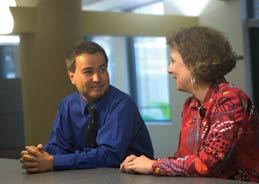Couple’s combined expertise forges new directions for treatment
On their way to school one morning, two middle-school boys skirted a crime scene where a high-schooler lay dead, shot just a few minutes earlier while waiting at a bus stop. By the time they got to their classroom about two blocks away, both boys started wheezing and coughing and used their asthma inhalers to regain control of their breathing.
This hypothetical scenario is a realistic example, say Harvard School of Public Health faculty members Rosalind Wright and Robert Wright, of how stress in impoverished neighborhoods affects health. And it will take more than prescription inhalers to solve the problem.
The Wrights, who are HSPH alumni, are using their combined expertise intoxicology, genetics, pulmonary medicine, and the effects of physical and social environments on health to change how medicine is practiced. Their goals are three-fold. First, they intend to document scientifically the role stressful environments play in creating medical problems that range from asthma to lead poisoning. Second, they want to get physicians talking with patients and their families about how these stressors cause and exacerbate disease. Finally, they hope to identify ways to intervene in the lives of children and adults who face the double burden of being poor and of being exposed to daily emotional distress—to help them live healthier lives.
Poor neighborhoods typically have more old and peeling lead-based paint than do more affluent locales. Already, the Wrights’ research suggests that when children are exposed to significant and persistent emotional stress, the added exposure to environmental lead results in brain damage at lower thresholds than previously suspected. Their research also provides a bright counterpoint: that the complications of lead poisoning might actually be mitigated if life stresses are reduced.
The Wrights and their colleagues first proposed this effect in humans in a paper based on the study of mother-child pairs in Mexico City, published in the March 2008 issue of Neurotoxicology. Animal studies had previously made the association.
“As a pediatrician, it has always bothered me that the literature cites the permanency of lead poisoning,” says Robert, MPH ’00, an associate professor of environmental health. “It makes no sense to me. Children’s brains are malleable. Why would lead cause permanent damage? My belief is that it doesn’t. We just don’t have the right intervention yet.”
COLLABORATORS IN WORK AND LIFE
As researchers, the Wrights often appear as co-authors on papers that break new ground. Common phrases in their published work include “no previous study” and “has not been studied among children.”
They met while both were attending medical school at the University of Michigan. Both plunged into clinical practice-Robert in pediatrics and Rosalind in pulmonary medicine. “We never went into medicine thinking we’d be doing anything comparable to our public health work,” says Rosalind, MPH ’96, an assistant professor of environmental health. “But listening to our patients, it was quite clear that the numerous social stressors they were dealing with affected our ability to provide good care and improve their health. That is what drew us to public health.” Both taught at the Harvard Medical School before coming over to the School of Public Health, and now hold joint appointments.

The professional collaboration developed gradually, as work-related conversations around the house kept revealing common threads. “I was studying the impact of metals such as lead on child development,” says Robert. “Roz had all these articles around the house on stress and brain development. The biological similarities between the two mechanisms we were studying were striking, and it just seemed to me there had to be a relationship.” When a medical literature search turned up nothing, it inspired a joint mission in public health. Both still see patients on a part-time basis, applying the results of their research directly in the clinic-Robert at Children’s Hospital and Rosalind at Beth Israel Deaconess Medical Center.
THE ASTHMA-VIOLENCE LINK
The Wrights are part of a small but growing movement of physicians incorporating environmental considerations into treatment of diseases and conditions. If scientific progress could be measured on a scale of 1 to 100, Robert says, the field is currently at 10 to 12. Research on asthma and lead poisoning have made the most headway.
Investigators have already linked physical factors such as air pollution, allergens, tobacco smoke, dust mites, and cockroaches to a greater risk of asthma and to more severe asthma. But that research, Rosalind says, only partially explains why asthma is concentrated in high-risk groups such as the urban poor. In a paper published in Clinics in Chest Medicine in 2006, she proposed that a “violence and urban asthma paradigm” exists in “socially toxic neighborhoods.”
An earlier paper she coauthored, in Environmental Health Perspectives in 2001, described four cases of Boston children in whom severe asthma attacks appeared to be triggered after they witnessed violence or were victims themselves. In a 2007 study published in the same journal, Rosalind and colleagues linked increased asthma risk to traffic-related air pollution and to exposure to violence. “Psychological stress disrupts the same biological pathways as does breathing in air pollution or tobacco smoke,” she says.
According to Rosalind, the couple’s physician colleagues were reluctant at first to start asking asthma patients and their parents about the stress in their lives. “I think the fear was that patients and families would consider the probing a violation of privacy,” she says. But once she and her fellow doctors started asking the questions, it became clear that patients appreciated someone talking with them about how community and domestic violence affects their asthma and health in general. As she explains, “It validated something the patients already knew was important.”
Today, physicians more frequently screen patients for exposure to violence, both inside and outside the home. “Once we more directly connected exposure to domestic violence to asthma risk in children, and emotional stress to specific metabolic pathways linked to asthma, colleagues in the medical community started listening,” says Rosalind. Indeed, physicians are beginning to view the myriad stressors in underprivileged neighborhoods as “social pollution” that affects risk for a wide range of diseases.
SOCIAL TOXINS BEHIND DISEASE
The couple’s research into lead poisoning shows that the combination of poverty and lead actually increases the toxicity in children. Traditionally, Robert says, physicians have considered lead poisoning untreatable; children with lead poisoning, who are usually poor, were believed destined to intellectual impairments that would prevent them from leading normal lives.
“In our approach, we’re hoping to show that interventions in the social environment may be a treatment for lead poisoning,” says Robert. “We’re saying these kids may be able to overcome their lead poisoning and enjoy productive lives.” And, he adds, “If we are right that social interventions work, the applications wouldn’t be limited to lead poisoning. Other toxicants could also be treated this way.”
The Wrights’ approaches have earned them respect among other researchers conducting similar studies. Rosalind “has pioneered the concept that, in addition to physical environment pollutants affecting asthma, there is a parallel construct of social pollutants,” says Edith Chen, associate professor in the department of psychology at the University of British Columbia in Vancouver and an asthma researcher.
And the application of Rosalind’s research in the clinic, Chen says, “is happening even now. She’s raising levels of awareness among physicians about social contributors to childhood asthma.”
The same is true for Robert’s innovative studies, notes Phillip Landrigan, director of the Children’s Environmental Health Center and professor of pediatrics and community and preventive medicine at Mount Sinai School of Medicine
in New York. “He’s at the forefront of looking at children’s health and at the toxicity of exposure to low levels of metals which five years ago were thought to be safe.” Further research into the effects of lead, iron, manganese, and other metals, Landrigan added, could likewise usher in changes in the way medicine is practiced.
BRIDGING SOCIETY AND ENVIRONMENT
The Wrights are part of a new breed of so-called “transdisciplinary” researchers at leading academic institutions such as Harvard. Although it is common for researchers from different fields to collaborate on studies in which each person brings his or her own special expertise to the table, the National Institutes of Health is increasingly funding studies in which a single researcher develops expertise across multiple disciplines.
Robert, first a pediatric toxicologist, expanded his expertise into genetics. Rosalind, first an adult pulmonary specialist, took on social and environmental determinants of health. They work separately on individual efforts and together as principal investigator and co-investigator in other studies.
Currently, Robert is leading an investigation, and Rosalind is one of the co-investigators, of children’s exposures to toxic metals at the Tar Creek Superfund site in Oklahoma. More than 40,000 people live in this 50-square-mile area where mining waste has left lead, manganese, cadmium, and other potentially harmful metals in the ground and water. Theirs is the first large-scale study into how exposure to manganese and arsenic at early ages may cause harm later in life.
Rosalind is also leading a major effort, and Robert is a co-investigator, for the Asthma Coalition on Community, Environment, and Social Stress, a study of how early life stressors, starting in pregnancy, affect the future risk of asthma in urban children. Study subjects include mothers and their children receiving care at Brigham and Women’s Hospital, Boston Medical Center, and urban health centers in Boston, in addition to women participating in federal Women, Infants, and Children programs in Boston and suburbs.
Both Wrights are working on a Mexico City study of social stressors, iron deficiency anemia, and lead exposure as environmental risk factors for poor neurodevelopment in children. Robert was senior author on an April 2008 Environmental Health Perspectives study showing that iron metabolism gene variants can modify lead metabolism and boost blood lead levels in young children in Mexico through gene-environment interactions. Their current study will lay the groundwork for development of social interventions based on scientific evidence.
Their work, says HSPH Department of Environmental Health Chair Douglas Dockery, “is a microcosm of what we do here at the School. The Wrights are bridging the physical environment and the social environment and the genetics, bringing together social sciences and biological sciences that were previously separated.”
“What we’re trying to do is stop looking at silos of disease causation—how much is due to genetics, chemicals, exposure to metals, or nutrition-and, instead, look at them all at once, to see how they interact,” says Robert. “That’s what happens in real life.”
Admittedly, their decades of collaborative work on such a complex public health topic won’t lead to a profitable “magic bullet” for medicine. “What we’re studying probably won’t make a lot of money for a company. And I can’t imagine a firm selling social and behavioral interventions,” Robert says. “But when you invest in children, it is better for society-and not just because they can contribute and pay taxes and bring in revenue. They also lead more meaningful lives.”
Photo by Kent Dayton/HSPH
Larry Hand is associate editor of the Review
